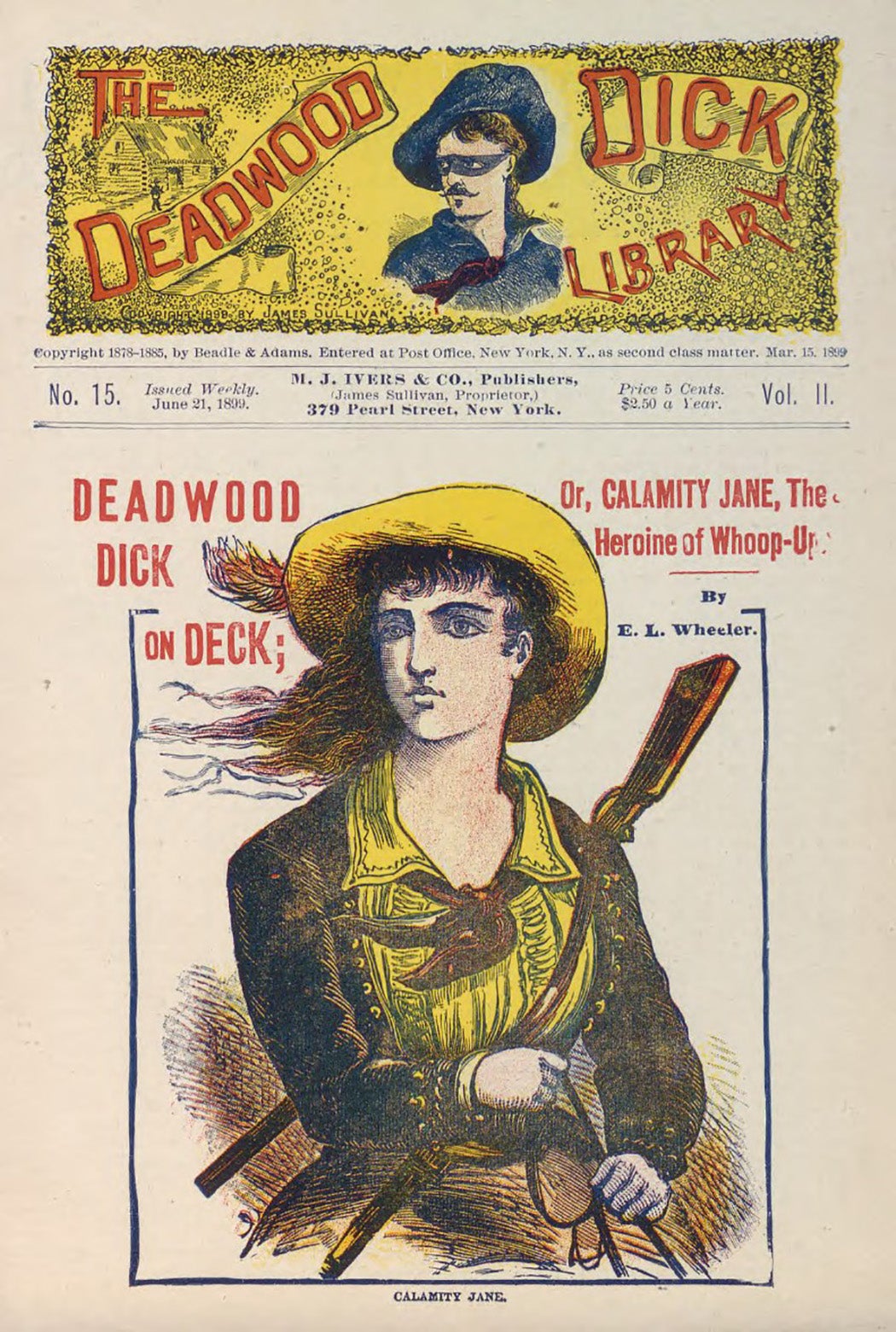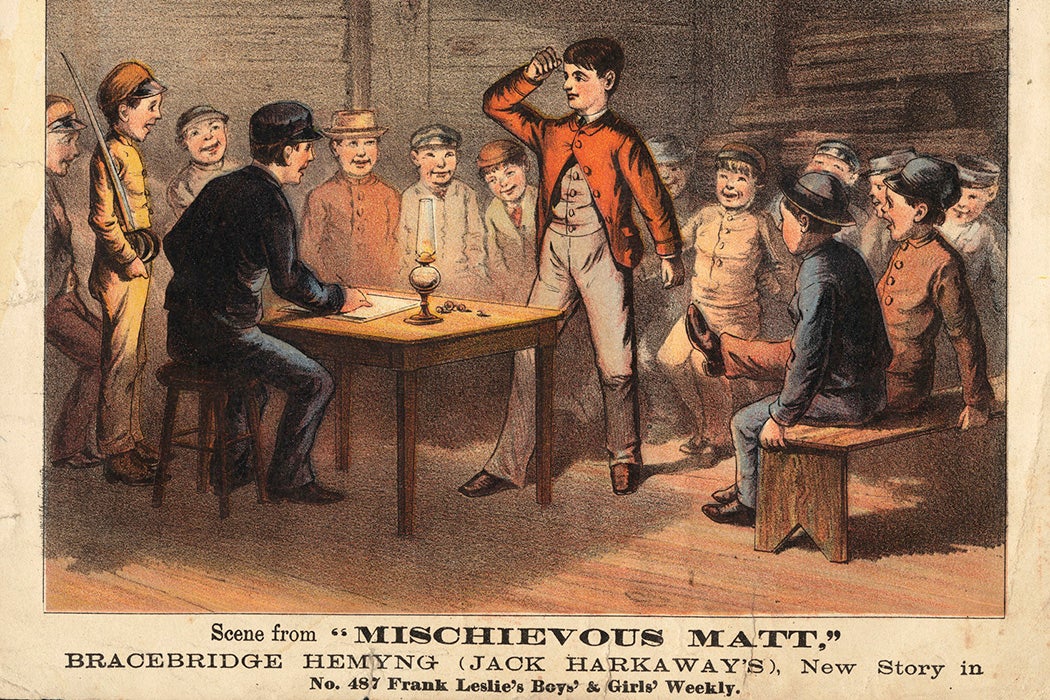The nineteenth century was an important and productive period in the United States for popular literature, thanks to the rise of pocket-sized dime novels and weekly illustrated “story papers” that combined all the serialized fiction, gossip, jokes, art, and intrigue that a reader could want. In contrast to what people mostly thought of as “literature” at the time—structured, serious, and artistically edifying—these quick-and-dirty publications were designed to cater to the public taste as well and as fast as possible. In that way, dime novels and their extended family of (guilty?) pleasures boosted the idea of pleasure reading in America and elevated the role of the audience in driving mainstream American entertainment.
These popular titles went by a handful of names and formats: story papers, dime novels, and nickel weeklies, to name a few of the most prominent types. These were published at different times in the nineteenth century but had certain things in common: they were inexpensively printed, were traded in excitement and adventure, and, thanks to their affordability and a rising literacy rate, were very, very popular.

Hundreds of titles appeared from the Civil War period onward, among them the New York Ledger and Beadle’s Dime Novels. Readers had their choice of exciting genres, from horror and crime fiction to college fiction and the adventures of avenging women. Dime novels provided a forum for women authors and were often a means for famous figures to write popular adventure, either under their own name or an address book’s worth of pseudonyms. These publications were an amalgam of bite-sized pop pleasures—and while adults loved them, it’s especially remarkable to note that many, for the first time, were specifically written for and marketed to children.
Papers like Frank Leslie’s Boys of America, Pleasant Hours for Boys and Girls, and Happy Days weren’t just something to occupy young readers, but they acted as an invitation into a no-adults-allowed participatory community of fandom. Story papers featured regular contests, puzzles, Q&A features, and letter sections, providing a venue in which children could, for a little while, feel empowered and independent. Author Sara Lindey called story papers a method by which young boys could “write themselves into adulthood.” (The audience, at least explicitly, was very often boys at this time—though papers often acknowledged that a sister, friend, and family members were of course welcome to pick up and enjoy the issue, and many did.)

Dime novels and story papers traded in Indiana Jones-style adventure and nostalgia for the golden glow of pre-industrial frontier America. An 1890 issue of Beadle’s Half-Dime Library had a title typical of the genre, starring “Butterfly Billy, the Pony Rider Detective.” Serials described adventure at sea, adventures with Indians, campfire adventures, jungle adventures; generally: adventure! (They arguably also invented the concept of the cliffhanger: an author in Writers Monthly in 1918 reminisced about the anxiety of waiting a whole week for a new issue when a writer “left his hero hanging by a cliff ‘a thousand feet above the valley’ for six whole days.”)
Celebrity authors engaged with children through the form, too: P. T. Barnum, for example, engaged co-authors to help him produce animal and adventure stories that had the double benefit of entertaining kids while slyly advertising his circus. He and science fiction pioneer Edward S. Ellis headlined the Golden Hours Club fan convention for children in Brooklyn in 1889.

Dime novels and story papers for kids were, like Barnum’s circus, generally daring but never truly dangerous—and this was a key tone to strike in the late nineteenth century. Childhood was coming to be understood not simply as a state of miniature adulthood, but as a unique time of life during which parents needed to protect and nurture their kids, to gradually and safely expose them to the variety and the danger of the larger world. As Jane Eva Baxter and Meredith Ellis wrote in Nineteenth Century Childhoods, children of the time “often became symbols of adult longings and concerns, and childhood was seen as an escape and an alternative from the realities of a changing world.” Thanks to stories and advertising, childhood was quickly romanticized in the minds of parents and in their physical homes, even when reality rarely lived up to the idealized nursery (something parents today no doubt will find familiar!).
Weekly Newsletter
Many parents worried that low-art dime novels were a bad influence. Author Margaret Cassidy notes that these books, designed to tuck discreetly into a kid’s pocket during the school day, raised many of the same concerns that parents today share about pocket-sized smartphones: she describes nineteenth-century commentary linking pop fiction with juvenile delinquency and crime, citing an 1884 article that warned: “the work of the teacher and preacher is made null and void by the Dime Novel.” In many cases, though, these publications attempted not only to entertain their young audience, but to teach upright, stereotypically masculine moral values: editors talked to young readers about selecting a good career, building muscle, and generally being as bold and strapping as the characters they read about. Story papers did engage with girls as an audience, but to a lesser degree and in an equally gendered manner: Lindey notes that, in advice columns, “While boys worried about the size of their bodies, the majority of girls’ answered letters, by far, have to do with beauty and instruct women to buy books and products.”
Dime novels and story papers faded in the twentieth century, as other forms of entertainment satisfied the public demand for popcorn stories, from motion pictures to pulp paperback fiction. But there’s no doubt that without the imaginative pop fiction of the 1800s, we wouldn’t today be able to enjoy the joys of beach reads, romance novels, fan conventions or comic books.
Support JSTOR Daily! Join our new membership program on Patreon today.







